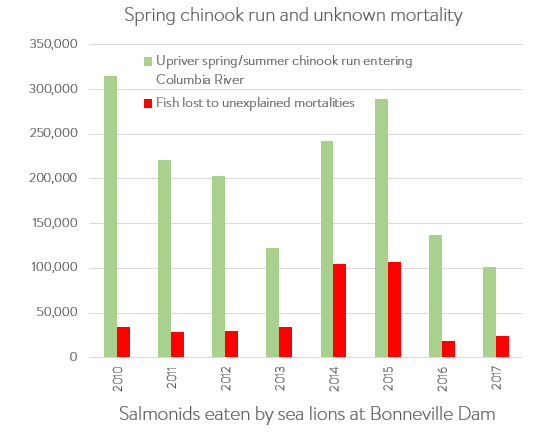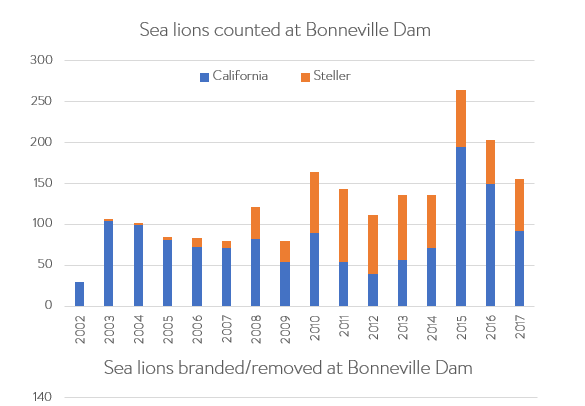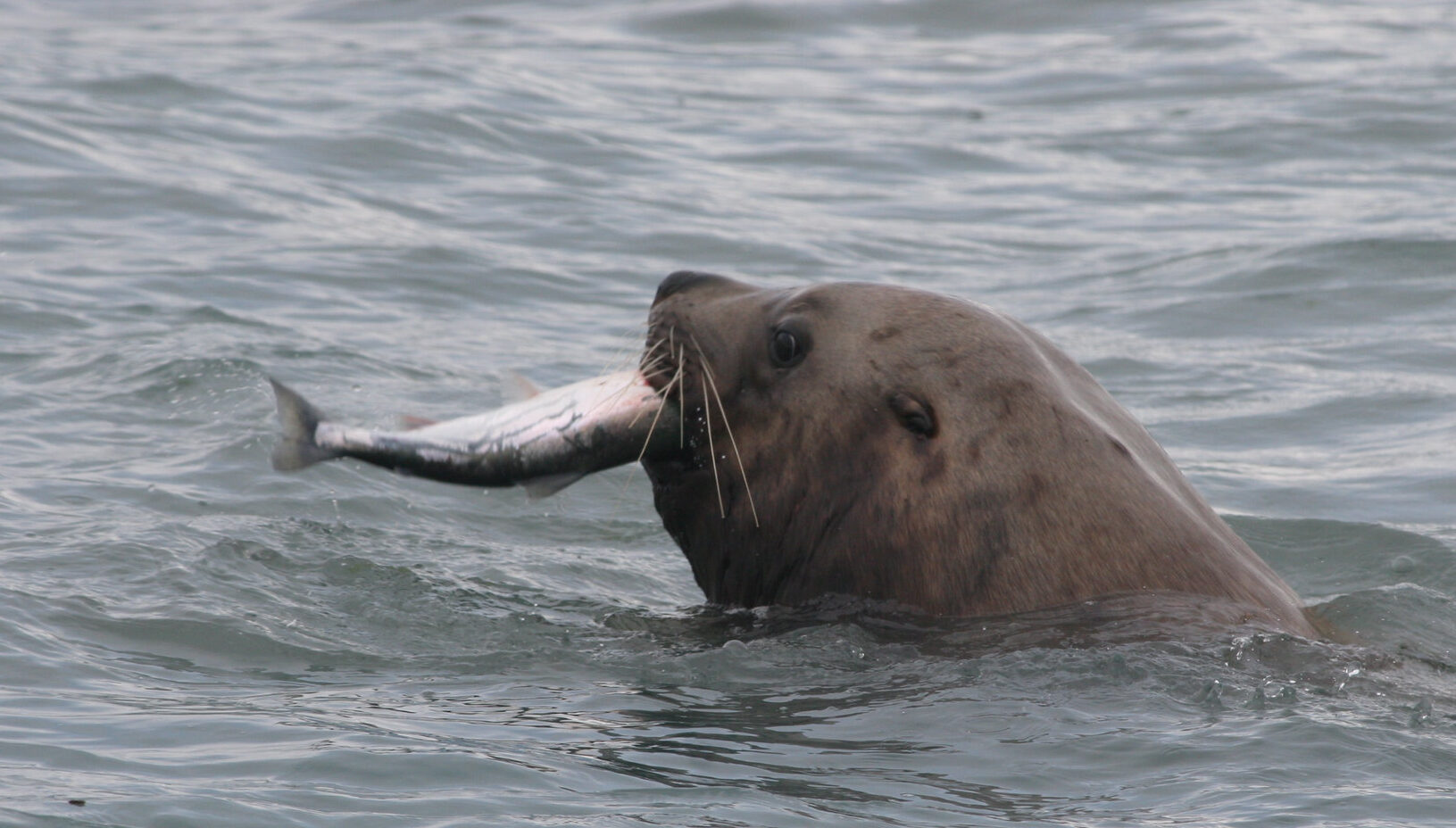A Challenge of Coexistence with Sea Lions
The Columbia River, once teeming with salmon, is now facing a crisis of declining fish populations, with implications for both ecosystems and human communities. At the heart of this issue lies the growing overpopulation of sea lions in the region.
Efforts to mitigate the conflict have included lethal removals of sea lions at chokepoints like the Bonneville Dam and Willamette Falls. Since 2008, nearly 400 sea lions have been euthanized in Oregon as part of these removal operations. However, the effectiveness of such measures remains a subject of debate, with concerns raised about the ethical implications and long-term sustainability of targeting sea lions as a solution to declining salmon populations.
Two charts provide valuable insights into the ecological challenges facing the region:

Chart 1: Decline in Salmon Population in the Columbia River Basin – This chart illustrates the downward trend in salmon populations over the years, highlighting the urgency of addressing the factors contributing to their decline.

Chart 2: Population Dynamics of Sea Lions – This chart tracks the population dynamics of sea lions over time, showing the correlation between their increasing numbers and the decline in salmon populations.
Recent sightings at the Barrier Dam on the Cowlitz River, located 70 miles upstream from the river’s mouth, highlight the extent of sea lions’ range and the challenges posed by their presence in inland waterways. Legislative efforts have sought to allocate funding for combating sea lion predation on salmon in the lower Columbia River and its tributaries. State Senator Jeff Wilson secured approval for $1.5 million in funding to address sea lion predation, reflecting growing recognition of the need to address this issue at the policy level.
The connection between the increase in sea lion populations and the decrease in salmon populations is evident from the data presented in the charts. As sea lion populations surge, their predation on salmon intensifies, further exacerbating the challenges faced by salmon populations already under pressure from various environmental stressors. Addressing the overpopulation of sea lions is thus essential for restoring the balance of ecosystems in the Columbia River Basin and ensuring the survival of endangered salmon and steelhead runs.
Washington State Senate Approves Funding to Combat Sea Lion Predation
Money to fight salmon-eating sea lions on the lower Columbia River and its tributaries has received approval from the state Senate. Senator Jeff Wilson, representing Longview, emphasized the urgent need for action, citing estimates that the region loses 12 percent of its salmon to hungry sea lions. The approved funding, totaling $1.5 million, represents a significant step towards addressing the ongoing challenge of sea lion predation in the area.
Increasing Concerns Over Sea Lion Predation
Sea lions, once confined to coastal areas, have increasingly ventured inland, posing a threat to salmon populations in rivers and dams. Recent sightings of sea lions at the Barrier Dam on the Cowlitz River, located 70 miles from the river’s mouth, underscore the urgency of addressing sea lion predation. Anglers and conservationists alike are expressing growing concerns over the impact of sea lion predation on already fragile salmon populations.
Boater’s Reckless Actions Targeting Sea Lions Spark Outrage and Investigation
In a disturbing incident captured on video, a boater on the Columbia River was observed intentionally targeting sea lions with his boat, causing outrage among onlookers. The video, filmed by a Portland man, depicts the boat weaving back and forth in an apparent attempt to hit the sea lions swimming near Hayden Island. Sea lions, federally protected under the Marine Mammal Protection Act, are safeguarded from harassment, hunting, or killing. The witness, Michael Brady, expressed dismay at the reckless behavior, noting the devastation felt by those witnessing the incident. Brady, a seasoned fisherman, acknowledged the frustrations within the fishing community due to the challenges faced in salmon fishing this year but condemned the boat driver’s actions as unjustifiable. The incident reflects the tensions surrounding the competition between fishermen and sea lions for fish stocks, highlighting the need for greater accountability and conservation efforts to protect marine wildlife. The investigation into the incident by authorities underscores the seriousness of the offense and the importance of upholding regulations to safeguard marine mammals in their natural habitat.
The Role of Policy in Addressing the Conflict
Legislative efforts to address the issue have gained momentum in recent years, with a focus on funding initiatives aimed at combating sea lion predation. The approval of funding by the Washington State Senate represents a crucial step towards implementing measures to mitigate the impact of sea lion predation on salmon populations. However, the long-term effectiveness of such measures remains uncertain, highlighting the need for ongoing research and collaboration between stakeholders.
Conclusion
The decline in salmon populations in the Columbia River Basin presents a complex challenge that requires a multifaceted approach. While efforts to address sea lion predation represent an important step towards mitigating the impact on salmon populations, long-term solutions must also consider broader environmental factors, including habitat restoration and sustainable fisheries management. By addressing the root causes of salmon decline we can work towards ensuring the health and resilience of ecosystems in the Columbia River Basin for future generations.
References:
- Sea Lions, Seals Seen 70 Miles Up Cowlitz River at Barrier Dam – Isabel Vander Stoep, The Chronicle
- Bonneville Sea Lion Removal Operations Ongoing, Just 2 Culled – Andy Walgamott, NWSportsmanMag
- The Damage Sea Lions Have On Salmon, May Get Funding – Eric Sharp, GoGraysharbor
- Why Male California Sea Lions Are Getting Bigger – Sarah Kuta, Smithsonian Magazine
- From High Seas to Hill Pleas – Bob Rees, ConserveFish
- Video captures boater running down sea lions on the Columbia River – Daisy Caballero, KGW
- Sea Lions, Seals Seen 70 Miles Up Cowlitz River at Barrier Dam – Isabel Vander Stoep, The Chronicle
- Population Charts from Freshwater Slaughter – John Harrison, Northwest Power and Conservation Council



Leave a Reply